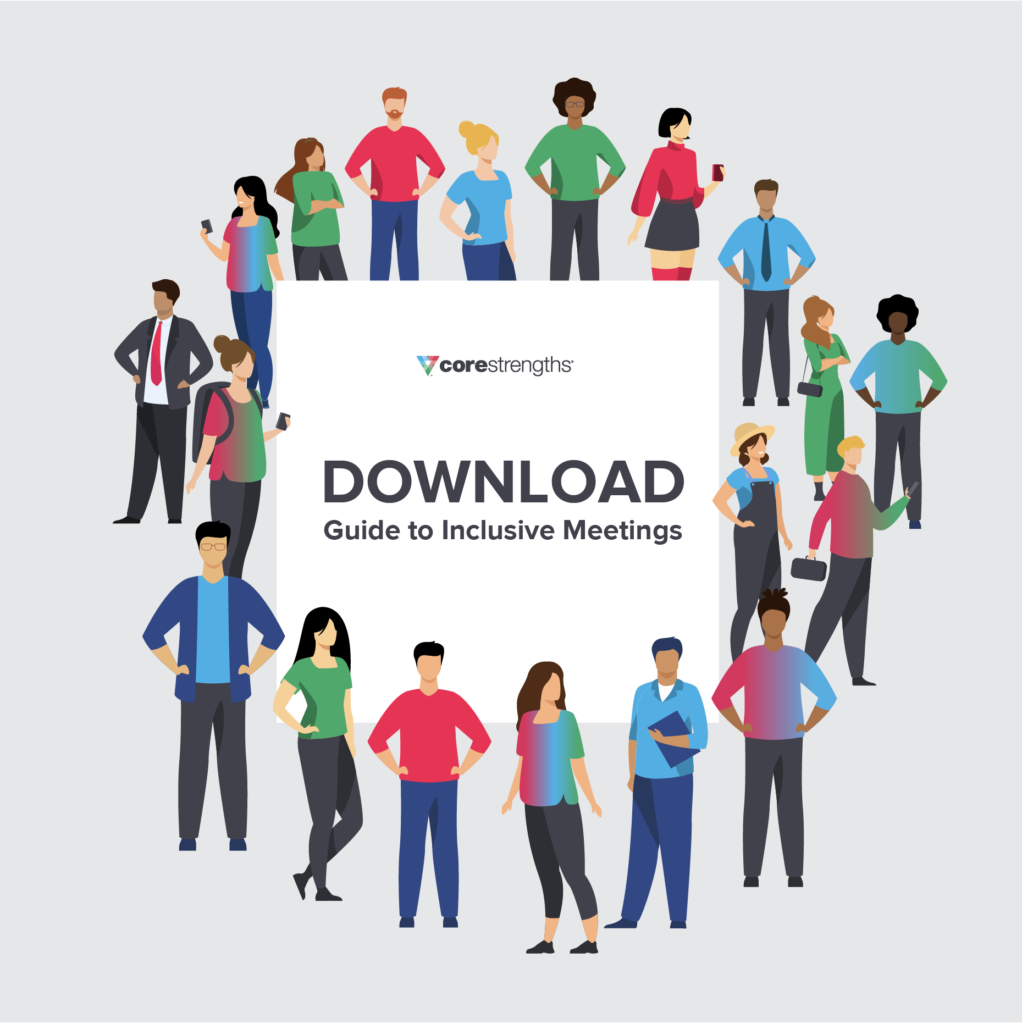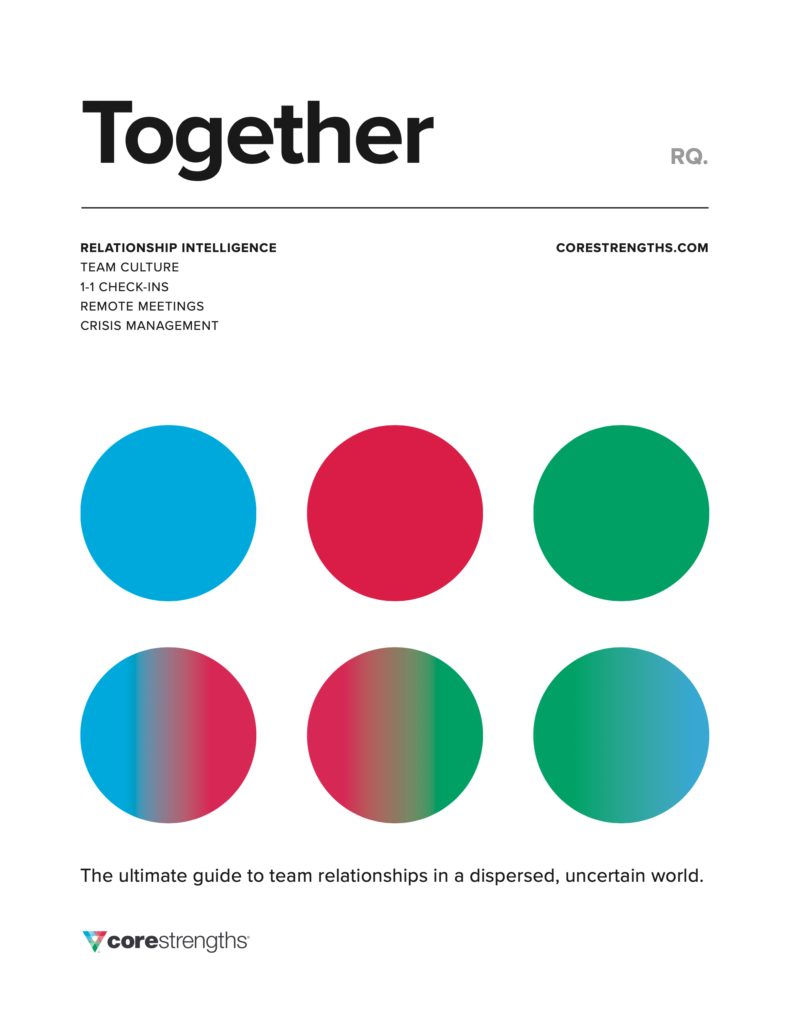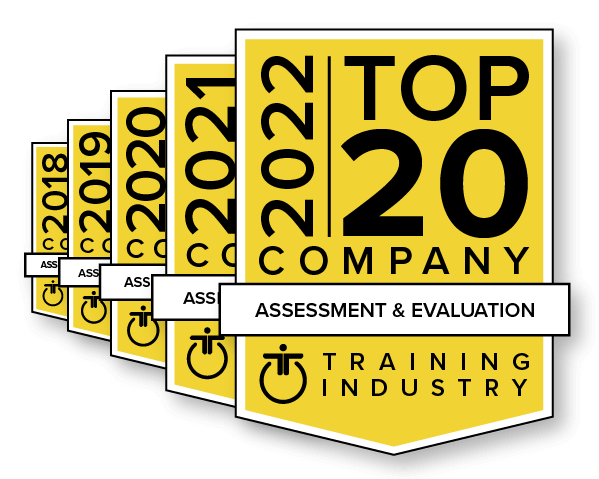“My employer may want me to feel included, but that’s the furthest from how I feel. I get excluded from meetings that I should attend. When I’m invited to meetings, I’m either ignored totally or talked over when I do attempt to contribute. I’m out of here—I’m looking for my next position.”
It’s an all-too-familiar story about lack of inclusion in the workplace. The company in the example above is about to lose a valuable resource because they don’t realize how much inclusion matters.
Inclusion in the workplace speeds up decision-making and commitment, and a Korn Ferry study found that inclusive teams make better business decisions up to 87% of the time.
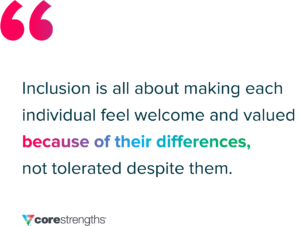
Inclusion is all about making each individual feel welcome and valued because of their differences, not tolerated despite them.
Why inclusion in the workplace matters.
As leaders, it’s important to know what matters to everyone on our team, including their views, values, and the things that energize them. Here’s why:
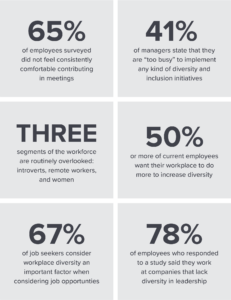
However, teams that have mastered diverse and inclusive meetings are:
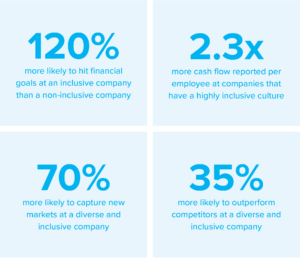
Inclusion creates internal motivation.
Leaders don’t create employee engagement. Employees decide internally to be engaged when their work taps into their value system and they have reasons for coming to work aside from the paycheck. The key is to understand those drivers and create opportunities for people to be their authentic selves; in other words, the key is inclusion.
When people feel included, they commit to the project, the team, and the organization. When they’re committed, they go above and beyond what’s required in their KPIs. They’ll make more effort, voice more ideas, and innovate more. They end the workday feeling energized, not drained and discouraged.
Inclusion makes your organization smarter.
The leader who says, “This is what I think is the solution” makes space for one brain in the room: their own. The leader who says, “This is the issue; what are your solutions?” makes space for as many brains in the room as there are people. They multiply the IQ of the group rather than diluting it.
It’s crucial for leaders to know what they don’t know, and lean on the people around them to come up with better solutions collectively. Every person on the team is an expert on something and can be a leader in some way. The challenge is to create an inclusive environment where everyone feels comfortable speaking up.
Inclusion helps you pressure-test ideas.
A good goal for inclusion in the workplace is increasing the number of ideas put forward and recognizing them as valid. But unfortunately, not all ideas will work in practical application.
An equally important goal is to create a safe environment to pressure-test ideas. People need both the opportunity and comfort level to put up their hand and say, “I don’t understand.”
This can be one of the most vulnerable sentences uttered in the workplace, even an inclusive one. But the act of asking clarifying questions, especially about another colleague’s pet project, can be the difference between a success and a flop.
How to foster inclusion in the workplace.
Now that you know why inclusion in the workplace matters, it’s time to take action. You can talk about inclusion at every meeting and even include it in your organisational values, but for it to become real, you need to lead by example. Here are some ways to do so:
Make others feel they belong.
A job description with attached KPIs doesn’t tell the employee “Why me?” or “Why now?” Have a one-on-one conversation with each person to get their perspective on how they fit into the team and what motivates them. This will help ensure that everyone knows why they’re in this organization, this team, this meeting, and this conversation.
Get to know them and let them get to know you.
Too often, we communicate with others in the way that we want to be communicated with, and they walk out of the room wondering what we were talking about. To include people in a way that works for them, you need to get to know who they are.
Spend time getting to know their personality, what matters to them, and the unique contributions they bring to the team and let them know the same things about you. Create a genuine two-directional contract for how you will work together for mutual benefit.
Create psychological safety.
An environment of psychological safety is one where it’s okay for everyone to be who they are, to disagree, and to say they don’t understand. To create a hospitable space for innovation and unique ideas, encourage people to think out loud—and give them your full attention when they do.
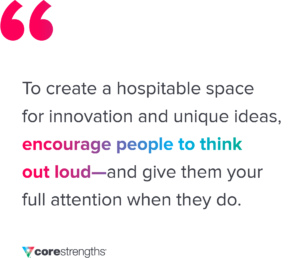
While you can’t act on every idea, make sure people know they’re valued, and so are their ideas. Once you shoot down an interjection in the wrong way, that person may never offer up another one.
Take responsibility for your own behavior.
Self-awareness will make you a more inclusive leader. If you’re often the most senior person in the room, ask yourself whether you habitually do some of the following things:
- Speak more than you listen
- Talk over someone or cut them off
- Move on to another subject or make a comment that dismisses what the person has said
- Pronounce your idea before you ask for contributions from others
To break these communication habits and promote inclusion in the workplace, practice opening your mind to new contributions instead of listening to confirm what you already know.
And, as illustrated by the following example, be willing to be vulnerable as the leader of the team:
Dave is the CEO of a large organization. During a team session, he voiced his frustration: “It’s my perception that the rest of the team don’t care as much as I do about the performance of the business,” he said. “Their lack of contribution makes them appear indifferent.”
As you can imagine, the room fell silent at his words. The facilitator then helped Dave consider other reasons why people might not have been contributing. He realized that he tended to dominate conversations, and the less other people talked, the more he did.
After the initial discussion, Dave made the following three commitments:
- I will allow people time to contribute in their way, which sometimes takes longer than I would like.
- I will be more inclusive by encouraging people to contribute during or even before the meeting.
- I will give the context of the meeting and will then allow others to speak.
Because he recognized his shortcomings and asked the team to hold him accountable, the rest of the team contributed much more for the rest of the session.
Encourage feedback.
It’s important to seek feedback on your leadership, because effective feedback is the only way to grow and improve. People probably won’t volunteer constructive suggestions to the boss, so ask for feedback and listen with the intent to understand it.
Then—and this is the most important step—do something about it. By changing your behavior, you show your colleagues and reports that you have humility and genuinely care about helping them in their job.
Note: you may have to ask several times, and even go so far as listing your shortcomings before people become willing to speak up. The first time you ask, “What am I doing that gets in your way?”, no one may answer.
Change the way you hold meetings.
In meetings, you can either build or destroy inclusion in the workplace.
- Before you send the invite, get clear about the type of meeting you’re holding, i.e. operational, tactical, strategic, etc.
- Invite the right people and make sure they know the type of meeting and why they’re there. Consider inviting people because they aren’t an expert, to get their fresh perspective.
- Solicit ideas in more than one way, such as giving attendees a chance to submit their thoughts before the meeting.
- In the meeting, leave nothing unsaid; parking lot meetings mean you didn’t have the right environment in the room.
- follow up after the meeting: take action, explain if some ideas were not adopted, and get feedback on the value of the meeting.
Get started improving inclusion in the workplace.
Fostering inclusion in the workplace isn’t a quick, one-off job. It takes time, commitment, honesty, and transparency as a leader. Start now, start with yourself, and acknowledge that the changes may take time to become habits.
The SDI 2.0 assessment from Core Strengths is a great first step to get to know your colleagues’ values, motives, and strengths—knowledge that leads to a better sense of inclusion in the workplace.
As your team works to improve inclusion as a group, you may want to review the blog together and be honest with your feedback to each other about your progress.
